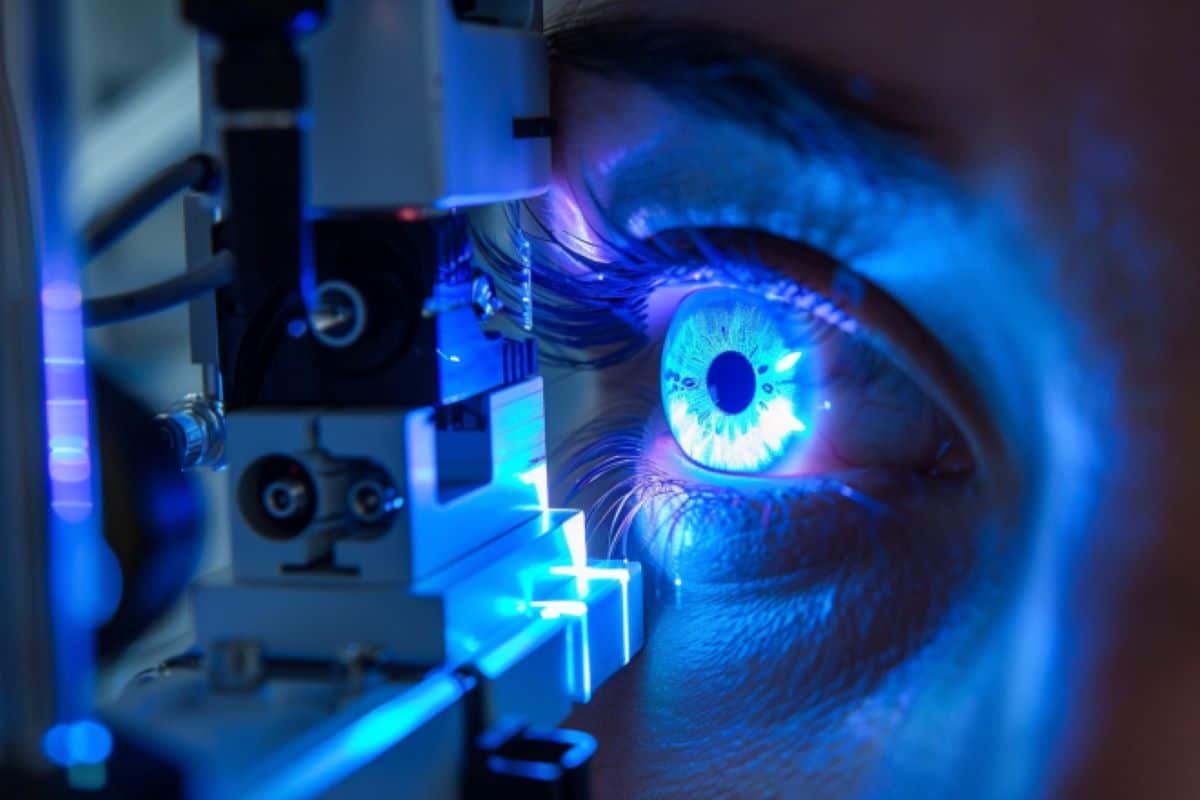Summary: Researchers successfully used a custom-built robot to treat wet age-related macular degeneration (AMD). This minimally invasive treatment reduces the need for frequent eye injections.
The landmark study found that robotic radiotherapy significantly decreases the number of injections needed, potentially saving millions annually. The new method offers precise targeting of radiation to the eye, improving patient outcomes and reducing costs.
Key Facts:
- The new robot system reduces the need for frequent eye injections in AMD patients.
- Robotic radiotherapy offers precise, targeted treatment, lowering disease activity.
- The study predicts significant savings for the NHS, reducing treatment burden for patients.
Source: King’s College London
Researchers from King’s, with doctors at King’s College Hospital NHS Foundation Trust, have successfully used a new robot system to improve treatment for debilitating eye disease.
The custom-built robot was used to treat wet neovascular age-related macular degeneration (AMD), administering a one-off, minimally invasive dose of radiation, followed by patients’ routine treatment with injections into their eye.
In the landmark trial, published today in The Lancet, it was found that patients then needed fewer injections to effectively control the disease, potentially saving around 1.8 million injections per year around the world.

Wet AMD is a debilitating eye disease, where abnormal new blood vessels grow into the macula, the light sensing-layer of cells inside the back of the eyeball. The vessels then start to leak blood and fluid, typically causing a rapid, permanent and severe loss of sight.
Globally, around 196 million people have AMD and the Royal College of Ophthalmologists estimates that the disease affects more than 700,000 people in the UK. The number of people with AMD is expected to increase 60% by 2035, due to the country’s ageing population.
Wet AMD is currently treated with regular injections into the eye. Initially, treatment substantially improves a patient’s vision. But, because the injections don’t cure the disease, fluid will eventually start to build up again in the macula, and patients will require long-term, repeated injections.
Most people require an injection around every 1-3 months, and eye injections, costing between £500 and £800 per injection, have become one of the most common NHS procedures.
The new treatment can be targeted far better than existing methods, aiming three beams of highly focused radiation into the diseased eye. Scientists found that patients having robotic radiotherapy required fewer injections to control their disease compared to standard treatment.
The study found that the robotically controlled device saves the NHS £565 for each patient treated over the first two years, as it results in fewer injections.
The study lead and first author on the paper, Professor Timothy Jackson, King’s College London and Consultant Ophthalmic Surgeon at King’s College Hospital said: “Research has previously tried to find a better way to target radiotherapy to the macula, such as by repurposing devices used to treat brain tumours. But so far nothing has been sufficiently precise to target macular disease that may be less than 1 mm across.
“With this purpose-built robotic system, we can be incredibly precise, using overlapping beams of radiation to treat a very small lesion in the back of the eye.
“Patients generally accept that they need to have eye injections to help preserve their vision, but frequent hospital attendance and repeated eye injections isn’t something they enjoy. By better stabilising the disease and reducing its activity, the new treatment could reduce the number of injections people need by about a quarter. Hopefully, this discovery will reduce the burden of treatment that patients have to endure.”
Dr Helen Dakin, University Research Lecturer at the University of Oxford said: “We found that the savings from giving fewer injections are larger than the cost of robot-controlled radiotherapy. This new treatment can therefore save the NHS money that can be used to treat other patients, while controlling patients’ AMD just as well as standard care.”
Funding: The research was jointly funded by the National Institute for Health and Care Research (NIHR) and the Medical Research Council (MRC) and recruited 411 participants across 30 NHS hospitals. A Lancet-commissioned commentary that accompanied the article described it as a “landmark trial”.
This study was led by researchers from King’s College London and doctors at King’s College Hospital NHS Foundation Trust, in collaboration with the University of Oxford, the University of Bristol and Queen’s University in Belfast.
About this robotics and visual neuroscience research news
Author: Rebecca Lewis
Source: King’s College London
Contact: Rebecca Lewis – King’s College London
Image: The image is credited to Neuroscience News
Original Research: Open access.
“Stereotactic radiotherapy for neovascular age-related macular degeneration (STAR): a pivotal, randomised, double-masked, sham-controlled device trial” by Timothy Jackson et al. The Lancet
Abstract
Stereotactic radiotherapy for neovascular age-related macular degeneration (STAR): a pivotal, randomised, double-masked, sham-controlled device trial
Background
Neovascular age-related macular degeneration (nAMD) is a leading cause of blindness. The first-line therapy is anti-vascular endothelial growth factor (anti-VEGF) agents delivered by intravitreal injection. Ionising radiation mitigates key pathogenic processes underlying nAMD, and therefore has therapeutic potential.
STAR aimed to assess whether stereotactic radiotherapy (SRT) reduces the number of anti-VEGF injections required, without sacrificing visual acuity.
Methods
This pivotal, randomised, double-masked, sham-controlled trial enrolled participants with pretreated chronic active nAMD from 30 UK hospitals. Participants were randomly allocated in a 2:1 ratio to 16-Gray (Gy) SRT delivered using a robotically controlled device or sham SRT, stratified by treatment centre.
Eligible participants were aged 50 years or older and had chronic active nAMD, with at least three previous anti-VEGF injections, including at least one in the last 4 months. Participants and all trial and image reading centre staff were masked to treatment allocation, except one unmasked statistician.
The primary outcome was the number of intravitreal ranibizumab injections required over 2 years, tested for superiority (fewer injections). The main secondary outcome was Early Treatment Diabetic Retinopathy Study visual acuity at two years, tested for non-inferiority (five-letter margin). The primary analysis used the intention-to-treat principle, and safety was analysed per-protocol on participants with available data.
The study is registered with ClinicalTrials.gov (NCT02243878) and is closed for recruitment.
Findings
411 participants enrolled between Jan 1, 2015, and Dec 27, 2019, and 274 were randomly allocated to the 16-Gy SRT group and 137 to the sham SRT group. 240 (58%) of all participants were female, and 171 (42%) of all participants were male. 241 participants in the 16-Gy SRT group and 118 participants in the sham group were included in the final analysis, and 409 patients were treated and formed the safety population, of whom two patients allocated to sham treatment erroneously received 16-Gy SRT.
The SRT group received a mean of 10·7 injections (SD 6·3) over 2 years versus 13·3 injections (5·8) with sham, a reduction of 2·9 injections after adjusting for treatment centre (95% CI –4·2 to –1·6, p<0·0001).
The SRT group best-corrected visual acuity change was non-inferior to sham (adjusted mean letter loss difference between groups, –1·7 letters [95% CI –4·2 to 0·8]). Adverse event rates were similar across groups, but reading centre-detected microvascular abnormalities occurred in 77 SRT-treated eyes (35%) and 13 (12%) sham-treated eyes.
Overall, eyes with microvascular abnormalities tended to have better best-corrected visual acuity than those without. Fewer ranibizumab injections offset the cost of SRT, saving a mean of £565 per participant (95% CI –332 to 1483).
Interpretation
SRT can reduce ranibizumab treatment burden without compromising vision.






